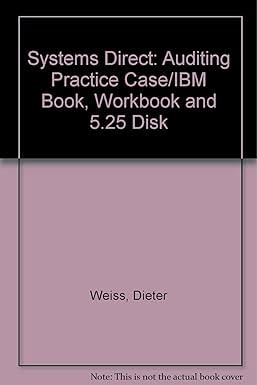Question
What is the difference between the plant-wide overhead allocation approach and the departmental overhead allocation approach? A. The plant-wide rate is determined from the average
What is the difference between the plant-wide overhead allocation approach and the departmental overhead allocation approach?
| A. | The plant-wide rate is determined from the average of the individual departmental rates. Using a plant-wide rate is a more efficient manner of accounting and providing management information |
| B. | The total plant rate is obtained by divided by the total number of departments. It is a more efficient manner of accounting and providing management information. |
| C. | The plant-wide allocation approach uses one cost pool to collect and apply overhead costs and has one predetermined overhead rate, while the departmental allocation approach uses several cost pools (one for each department) and has several predetermined overhead rates |
| D. | The plant-wide allocation approach sets a predetermined rate for each department and averages this into a plant-wide allocation, while the departmental allocation approach uses several cost pools (one for each department) and has several predetermined overhead rates. |
Als Wooden Turnings (AWT Company) makes two products: funerary urns and salad bowls. The company produces 4,000 salad bowls and 2,000 urns per year. Each urn requires two hours of direct labor to produce, and each bowl requires one hour of direct labor to produce.
The following table summarizes the direct material and labor costs for each item:
|
| Urns | Bowls |
| Direct material/unit | $20 | $15 |
| Direct labor/unit | $30 | $15 |
Als Wooden Turnings factory has an annual estimated overhead of $250,000, as follows:
| Activity | Budgeted Overhead | Estimated Volume/Number |
| Machine setups | $100,000 | 120 setups |
| Manufacturing raw wood to product | $100,000 | 50,000 bf (board feet) |
| Finishing wood and packing | $50,000 | 6000 items |
| Total Overhead | $250,000 |
|
From an internal analysis it appears that the two products required the following activity levels for 2015:
| Activity | Urns | Bowls | Totals |
| Machine setups | 40 setups | 80 setups | 120 setups |
| Manufacturing raw wood to product | 30,000 bf | 20,000 bf | 50,000 bf |
| Finishing wood and packing | 2,000 urns | 4,000 bowls | 6,000 items |
Using activity based costing, what is the total per-unit cost of each urn. _______________.
Step by Step Solution
There are 3 Steps involved in it
Step: 1

Get Instant Access to Expert-Tailored Solutions
See step-by-step solutions with expert insights and AI powered tools for academic success
Step: 2

Step: 3

Ace Your Homework with AI
Get the answers you need in no time with our AI-driven, step-by-step assistance
Get Started


